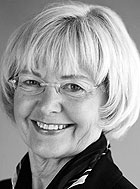A five-year, $3 million grant from the National Institute of Arthritis and Musculoskeletal and Skin Diseases (NIAMS), will allow investigators from more than 50 laboratories at Washington University School of Medicine in St. Louis to join forces in the fight against musculoskeletal disorders.
The grant funds a Core Center for Musculoskeletal Biology and Medicine. Its goal is to better understand causes and potential treatments for muscle and bone disorders, including osteoporosis, osteoarthritis and muscular dystrophy. The center also is designed to aid in the development of new and better ways to regenerate bone, cartilage, tendons and muscle tissue.
“This center represents a major step forward in our efforts to treat bone and muscle diseases,” says Larry J. Shapiro, M.D., executive vice chancellor for medical affairs and dean of the School of Medicine. “As our researchers collaborate to make new discoveries and to translate those discoveries into better patient care, combining the efforts of scientists from multiple departments will improve communication and cooperation in ways that can speed the pace of discovery.”
The center will support and expedite the creation and study of animal models relevant to musculoskeletal biology and disease. Investigators will be organized into three research cores: One core will deal with musculoskeletal structure and strength. A second will analyze the molecular structures of both healthy and sick bones, muscles and connective tissue, and a third core will use genetic engineering techniques to create mouse models of various muscle, bone and connective tissue diseases.
“This effort complements related research housed in the Division of Bone and Mineral Diseases in the Department of Medicine, “says Kenneth S. Polonsky, M.D., the Adolphus Busch Professor and head of the Milliken Department of Medicine. “Such cross-disciplinary, interdepartmental research is key to making more rapid progress in understanding and treating muscle and bone diseases.”
Traditionally, the majority of research into muscle and bone diseases has been conducted by investigators in the Departments of Medicine, Pathology and Orthopaedic Surgery, but in recent years, those investigators have launched collaborations with scientists in anatomy and neurobiology, biomedical engineering, cell biology, developmental biology, genetics and pediatrics. Part of the reason for creating the new center is to improve communication between all of those researchers from different, and often unrelated, areas of the University.

“Musculoskeletal disorders affect most Americans over 50 years old, as well as many younger, very active individuals,” says center director Linda J. Sandell, Ph.D., the Mildred B. Simon Professor of Orthopaedic Surgery. “Although Washington University has a long record of excellence in musculoskeletal research and clinical care, much of that research has occurred in individual laboratories that may, or may not, regularly communicate with colleagues in other departments. This effort was developed to unify and expand research in basic and translational studies that will improve the quality of life in our aging population.”
In addition to Sandell, the center’s co-directors will be Steven Teitelbaum, M.D., the Messing Professor of Pathology and Immunology, and Matthew Silva, Ph.D., associate professor of orthopaedic surgery. All of the investigators who will work as part of the center have grant support from the National Institutes of Health for their bone and muscle studies.
“This center represents another step in creating a comprehensive approach to aid our research and clinical efforts by bringing together basic scientists from many disciplines, as well as top-notch clinical researchers, to coordinate several parallel efforts to improve our understanding of musculoskeletal disorders and to more quickly take that knowledge from the laboratory into the clinic,” says Richard H. Gelberman, M.D., the Fred C. Reynolds Professor and head of Orthopaedic Surgery.
The center complements Washington University’s BioMed 21 initiative, a strategic program begun in 2003 to facilitate multidisciplinary, collaborative research and rapidly apply breakthroughs to patient care.
Washington University School of Medicine’s 2,100 employed and volunteer faculty physicians also are the medical staff of Barnes-Jewish and St. Louis Children’s hospitals. The School of Medicine is one of the leading medical research, teaching and patient care institutions in the nation, currently ranked third in the nation by U.S. News & World Report. Through its affiliations with Barnes-Jewish and St. Louis Children’s hospitals, the School of Medicine is linked to BJC HealthCare.